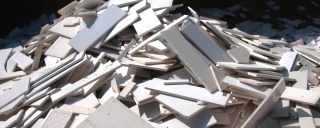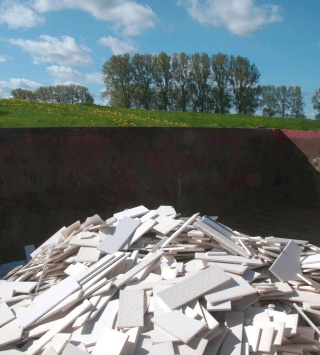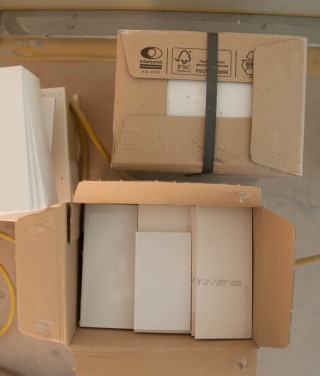PRESS RELEASE
November 4, 2019
Mosa is developing circular tile systems in the construction industry
The tile manufacturer not only works on its own sustainability objectives but also stimulates sustainable development in general.
Conceptual designs that fire the imagination, intriguing applications, and a continued focus on design and sustainability. That is where Mosa has made a name for itself and what it stands for as a company. The company has been designing the future for 136 years now. When they started out, they were producing porcelain but it wasn’t long before tiles were added to the mix. Mosa was never afraid to get controversial designers on board, introduce contemporary designs, and be guided in its business philosophy by the concept of circularity.

Secondary raw materials
Mosa has been pushing boundaries with regard to sustainability for many years. Not only does the company follow the Cradle to Cradle principles and are nearly all tiles Cradle to Cradle Silver certified, Mosa is also constantly working on circular systems, circular design, and circular sourcing in the construction sector. This innovation is urgently needed to achieve the climate targets set in Paris. “The construction sector can make a substantial contribution of up to 45 percent to the required reduction in CO₂ emissions through the circular use of materials.” These are the words of Dorien van der Weele, Sustainability Manager. “As a tile manufacturer, we are part of this sector. Mosa has numerous intentions when it comes to sustainability. For example, we are thinking about how to handle secondary raw materials. We want to design our business models in such a way that we can reclaim products in order to reuse them or incorporate them in new products. We are also investigating how we can use third-party waste to make products as well as how others can produce new products from our waste.”
Tile take-back campaigns
Mosa has been taking back cutting residues from tiles for seven years now. These so-called take-back campaigns, that Mosa set up in the Netherlands for this purpose, form a pilot project to test how circular systems can work. Mosa currently recycles all the production waste from its tiles and is investigating the possibilities of reusing glaze residues. However, cutting residues from tiles in the construction sector are also collected and used as raw materials in the production of new tiles. Van der Weele explains: “Cutting residues are simply new tiles that can be reused. Currently, there is a limit on how much of this cutting residue can be used, but we certainly use cutting residues to supplement the primary raw materials. A challenge we face with our take-back campaigns is returning the cutting residues to the raw material manufacturer as efficiently as possible, with the smallest possible carbon footprint. Together with our partners, we are searching for solutions to this issue.”

Leasing Mosa façade systems
“Our ideas go further than the use of secondary raw materials. For years now, we have been working on circular systems, such as our Cradle to Cradle Silver certified façade system, Mosa Facades. Our tiles are attached to façades with the aid of mechanically affixed components so that all the components in this system can be separated and reused at a later date, as a façade, as tiles, or as raw materials for new products. Now that we have taken this step, we’re ready for the next step, which is thinking about how you reintroduce systems to the circular economy that can be separated from each other. At the moment, for instance, we’re busy investigating whether our façade systems can be leased or can be returned on a deposit scheme. In this way, we are creating an incentive for users to get actively involved in the circular economy. And that’s not all because what we can do with façade systems should also be possible with floors and walls. We are now working on, among other things, introducing and improving click fitting systems for flooring, which means applying tiles in modules that can easily be removed and reused after they have been installed. This type of system is already used in settings such as trade shows. It works well and also offers possibilities for larger surface areas.”

Tiles with a material passport
Another campaign that Mosa is strongly committed to is keeping structured and detailed documentation of the identity of materials in a building. A passport helps prevent waste and promotes reuse when the building is renovated or demolished. It’s a great example of how circular systems can be designed and used. Van der Weele explains: “Waste used to be a material with no identity. However, thanks to an increasing desire to build in a circular way and thus prevent waste and reduce a building’s CO2 footprint, more and more materials - and thus indirectly buildings - are being given a passport. In the Netherlands, materials are registered in Madaster, for example, which makes it possible to trace and reuse them. We are proud that, in addition to our Cradle to Cradle® Silver certification, our tiles serve as an example for EPEA’s Material Passport®. Thanks to these types of innovations, we can not only meet our own sustainability objectives, but also those of our clients, and so stimulate sustainable development in general. And that’s what it’s all about.”
